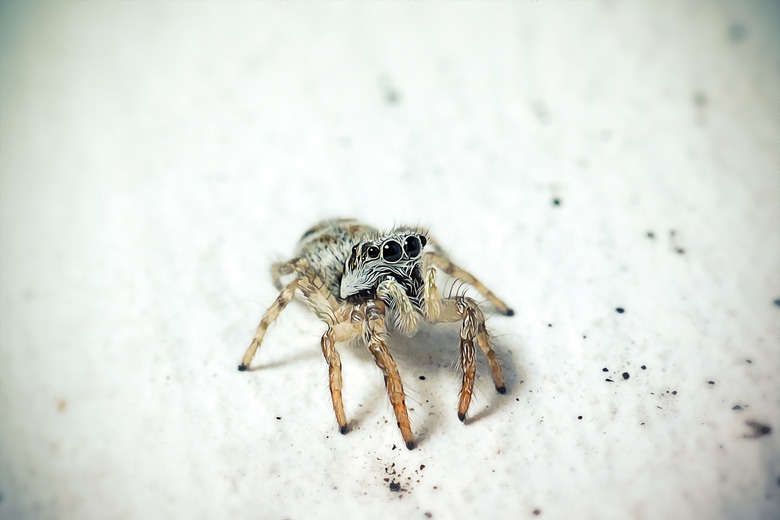Common Northeast U.S. Spiders
Many different species of spiders live throughout the Northeastern United States. For example, at least 50 different species of spiders live in New York alone! Though these eight-legged arachnids can strike fear into the hearts of some, the vast majority of United States spider species do not pose a danger to humans. Northeast spiders make up an incredibly diverse group, and many commonly live in and around homes, gardens and the surrounding areas.
Yellow Sac Spiders: Most Likely to Bite You
Yellow Sac Spiders: Most Likely to Bite You
When you're dutifully weeding your garden and come away with a spider bite, a yellow sac spider is the most likely culprit. Relatively aggressive and prone to biting, these spiders potentially account for a large volume of reported bites in the Northeast. Two species of yellow sac spiders, and several other sac spider species, live in the Northeast.
Bites from yellow sac spiders can result in burning, swelling, rash development, blistering and even a necrotic lesion around the area. Some also reported nausea, malaise, muscle cramps and/or fever. Medical professionals often mistake the bites of these spiders with those of the brown recluse, which does not regularly range into the Northeastern United States.
Northern Black Widow Spiders
Northern Black Widow Spiders
Black widows are the only other regularly encountered venomous Northeast spiders. You might be surprised to find that researchers recognize three different "black widow" species in the United States: the western black widow, the southern black widow and the northern black widow. The northern black widow is the only species endemic to the Northeastern United States.
Though not quite as venomous as their southern cousin, the northern black widow does pose a danger to humans. It typically only bites when threatened or disturbed, so use caution when reaching into dark crevices or corners. Young children, the elderly and those who are immune-compromised face the most danger from a black widow bite.
American House Spiders: The Common House Spider
American House Spiders: The Common House Spider
Perhaps one of the most common Northeastern United States spiders, if not one of the most commonly encountered spiders in North America, the common house spider takes refuge in homes across the country. Also known as the American house spider, these little brown arachnids commonly inhabit attics, cellars and other dark, damp places. You can readily find common house spiders in New York, throughout the Northeast and in the rest of the United States.
Harvestmen: The Spider Who Isn't Really a Spider
Harvestmen: The Spider Who Isn't Really a Spider
Harvestmen, also known as "daddy-long-legs," are common Northeast "spiders." However, they aren't true spiders! Though harvestmen look like spiders and fall under the arachnid family, they're actually more closely related to ticks than they are to spiders. Despite common lore that these spiders have toxic venom but cannot bite people with their tiny fangs, daddy-long-legs do not produce any venom.
People frequently mistake harvestmen for another of the common northeast spiders, cellar spiders. Cellar spiders also sport long, skinny legs and small bodies. You can often find cellar spiders clinging upside down from their webs, which they suspend from the ceiling of cellars and basements.
Wolf Spiders: Commonly Mistaken for Brown Recluse
Wolf Spiders: Commonly Mistaken for Brown Recluse
Relatively large and furry-looking, you can find wolf spiders scurrying along the ground in search of prey. These creatures use their long legs to chase down their prey rather than catching it in a web. Wolf spiders make surprisingly dedicated parents. Females carry their eggs in a silk egg sac on their underside. Once the young hatch, the female continues to carry them on her back for some time to keep them safe from predators.
Jumping Spiders: Stout, Stocky and Adorable
Jumping Spiders: Stout, Stocky and Adorable
Named for their ability to hop surprisingly long distances to catch prey, jumping spiders have stocky bodies, stout legs and large eyes. One of the cuter and more personable types of spiders, these creatures use their excellent eyesight to focus on and watch people as they approach. These spiders have fuzzy-looking bodies, often with bright coloration and stripes or spots. You can find several different jumping spider species in the Northeast, including the bronze, tan, dimorphic and zebra jumper.
References
- New York State Department of Environmental Conservation: Common Spiders
- Rest Easy Pest Control: Spiders in New York
- Ortho: The Most Common House Spiders
- Michigan State University: Yellow Sac Spiders
- Bug Guide: Northern Black Widow
- Spider ID: Spiders in New York
- Live Science: Black Widow Spider Facts
Cite This Article
MLA
Zinni, Yasmin. "Common Northeast U.S. Spiders" sciencing.com, https://www.sciencing.com/common-northeast-spiders-8405424/. 30 September 2021.
APA
Zinni, Yasmin. (2021, September 30). Common Northeast U.S. Spiders. sciencing.com. Retrieved from https://www.sciencing.com/common-northeast-spiders-8405424/
Chicago
Zinni, Yasmin. Common Northeast U.S. Spiders last modified March 24, 2022. https://www.sciencing.com/common-northeast-spiders-8405424/
